Study of Draft Tube Optimization Using a Neural Network Surrogate Model for Micro-Francis Turbines Utilized in the Water Supply System of High-Rise Buildings
Abstract
:1. Introduction
2. Methodology
2.1. Francis Turbine Model and Modified Draft Tube
2.2. Research Methods of Draft Tube
2.3. Numerical Simulation
2.3.1. Grid Generation
2.3.2. Simulation Settings
2.3.3. Lab Tests
3. Results and Discussion
3.1. Radius Analysis of Draft Tube
3.2. Determine the Boundary Conditions
3.3. RBFNN Model Optimization
3.3.1. Creation of an Initial Uniform Set of Samples
3.3.2. Investigation of Nonlinear Relationships
3.3.3. Validation of RBFNN Model
3.3.4. Search for Optimal Parameters
3.4. Numerical Simulation Validations
- The numerical model of the turbine is a simplified model, which makes the hydraulic losses occurring inside the turbine not accurately predicted;
- The mechanical losses and leakage losses assessment methods used in this study were originally applied to pumps, which makes the loss assessment results inaccurate;
- There are inevitably errors in the manufacture of the prototype, instrumentation measurement errors, etc., which will have an impact on the lab test results of turbine performance.
3.5. Analysis of Optimization Results
4. Conclusions
- For this micro-Francis turbine, the different radius distribution of the draft tube sections did not have a significant effect on the output power. Considering fewer input variables can lead to more accurate prediction models, the equal radius draft tube was adopted to reduce the input variables.
- A correlation analysis between design variables and optimization objectives was performed using the Pearson correlation coefficient. The results showed that the correlation coefficients r between different design variables and the optimization objective are small, which indicates that the design variables are nonlinearly correlated with the optimization objective.
- The model errors of the standard response surface functions, radial basis function and Kriging function are compared under the same date sets, and the results showed that the R2 of the radial basis function is the highest among the three, and the RMSE and MRE are both the smallest. It was verified that RBFNN has higher accuracy than other models in nonlinear approximation.
- Compared with the initial prototype, the optimized micro-Francis turbine shows a considerable improvement. The lab tests showed that the proposed turbine produces a power of 147 W with an efficiency over 29% under the design conditions.
Author Contributions
Funding
Data Availability Statement
Conflicts of Interest
Nomenclature
| Q | Flow rate (m3/s) | H | Water head (m) |
| n | Rotational speed (r/min) | ρ | Density of water (kg/m3) |
| Pinlet | Inlet pressure (pa) | Poutlet | Outlet pressure (pa) |
| Pt | Theoretical power (W) | Ps | Mechanical shaft power (W) |
| Pe | Output power (W) | ηt | Total efficiency |
| ηs | Shaft conversion efficiency | ηe | Generator conversion efficiency |
| ηh | Hydraulic efficiency | ηl | Leakage efficiency |
| ηm | Mechanical efficiency | T | Shaft output torque (Nm) |
| r | Pearson correlation coefficient | R2 | Coefficient of determination |
Abbreviations
| RBFNN | Radial basis function neural network |
| SQPA | Sequential quadratic programming algorithm |
| WSS | Water supply system |
| PRV | Pressure reducing valve |
| RMSE | Root mean square error |
| MRE | Maximum relative error |
| RANS | Reynolds averaged Navier-Stokes |
References
- Lotfabadi, P. High-rise buildings and environmental factors. Renew. Sustain. Energy Rev. 2014, 38, 285–295. [Google Scholar] [CrossRef]
- Park, J.H.; Chung, M.H.; Park, J.C. Development of a small wind power system with an integrated exhaust air duct in high-rise residential buildings. Energy Build. 2016, 122, 202–210. [Google Scholar] [CrossRef]
- Wong, L.T.; Mui, K.W.; Zhou, Y. Energy efficiency evaluation for the water supply systems in tall buildings. Build. Serv. Eng. Res. Technol. 2017, 38, 400–407. [Google Scholar] [CrossRef]
- Cheung, C.T.; Mui, K.W.; Wong, L.T. Energy efficiency of elevated water supply tanks for high-rise buildings. Appl. Energy 2013, 103, 685–691. [Google Scholar] [CrossRef]
- Zhu, Y. Forms and problems of secondary water supply in high-rise buildings and suggestions. City Inf. 2022, 13, 232–234. [Google Scholar]
- Du, J.; Yang, H.; Shen, Z.; Chen, J. Micro hydro power generation from water supply system in high rise buildings using pump as turbines. Energy 2017, 137, 431–440. [Google Scholar] [CrossRef]
- Gupta, A.; Bokde, N.; Kulat, K.; Yaseen, Z.M. Nodal Matrix Analysis for Optimal PRV Localization in a Water Distribution System. Energies 2020, 13, 1878. [Google Scholar] [CrossRef]
- Kougias, I.; Aggidis, G.; Avellan, F.; Deniz, S.; Lundin, U.; Moro, A.; Muntean, S.; Novara, D.; Pérez-Díaz, J.I.; Quaranta, E.; et al. Analysis of emerging technologies in the hydropower sector. Renew. Sustain. Energy Rev. 2019, 113, 109257. [Google Scholar] [CrossRef]
- Okot, D.K. Review of small hydropower technology. Renew. Sustain. Energy Rev. 2013, 26, 515–520. [Google Scholar] [CrossRef]
- Liu, X.; Luo, Y.; Karney, B.W.; Wang, W. A selected literature review of efficiency improvements in hydraulic turbines. Renew. Sustain. Energy Rev. 2015, 51, 18–28. [Google Scholar] [CrossRef]
- Sari, M.A.; Badruzzaman, M.; Cherchi, C.; Swindle, M.; Ajami, N.; Jacangelo, J.G. Recent innovations and trends in in-conduit hydropower technologies and their applications in water distribution systems. J. Environ. Manag. 2018, 228, 416–428. [Google Scholar] [CrossRef] [PubMed]
- Xiong, C.; Yu, B.; Li, W. Design and Performance Forecasting of Micro-channeis Turbine Based on Numerical Test. China Rural Water Hydropower 2009, 2, 130–132. [Google Scholar]
- Guo, H.; Wang, H.; Zheng, Y.; Shi, J.; Kan, K. Optimal design of micro-pipe turbine based on orthogonal test method. J. Drain. Irrig. Mach. Eng. (JDIME) 2022, 40, 928–935. (In Chinese) [Google Scholar]
- Graciano-Uribe, J.; Sierra, J.; Torres-Lopez, E. Instabilities and influence of geometric parameters on the efficiency of a pump operated as a turbine for micro hydro power generation: A review. J. Sustain. Dev. Energy Water Environ. Syst. 2021, 9, 1–23. [Google Scholar] [CrossRef]
- Arispe, T.M.; de Oliveira, W.; Ramirez, R.G. Francis turbine draft tube para-meterization and analysis of performance characteristics using CFD techniques. Renew. Energy 2018, 127, 114–124. [Google Scholar] [CrossRef]
- Chen, Z.; Baek, S.H.; Cho, H.; Choi, Y.D. Optimal design of J-groove shape on the suppression of unsteady flow in the Francis turbine draft tube. J. Mech. Sci. Technol. 2019, 33, 2211–2218. [Google Scholar] [CrossRef]
- Zhou, X.; Wu, H.; Cheng, L.; Huang, Q.; Shi, C. A new draft tube shape optimisation methodology of introducing inclined conical diffuser in hydraulic turbine. Energy 2023, 265, 126347. [Google Scholar] [CrossRef]
- Dai, C.; Che, H.; Leung, M.F. A neurodynamic optimization approach for l 1 minimization with application to compressed image reconstruction. Int. J. Artif. Intell. Tools 2021, 30, 2140007. [Google Scholar] [CrossRef]
- Hasanzadeh, N.; Payambarpour, S.A.; Najafi, A.F.; Magagnato, F. Investigation of in-pipe drag-based turbine for distributed hydropower harvesting: Modeling and optimization. J. Clean. Prod. 2021, 298, 126710. [Google Scholar] [CrossRef]
- Mengistu, T.; Ghaly, W. Aerodynamic optimization of turbomachinery blades using evolutionary methods and ANN-based surrogate models. Optim. Eng. 2008, 9, 239–255. [Google Scholar] [CrossRef]
- Du, J.; Ge, Z.; Wu, H.; Shi, X.; Yuan, F.; Yu, W.; Wang, D.; Yang, X. Study on the effects of runner geometric parameters on the performance of micro Francis turbines used in water supply system of high-rise buildings. Energy 2022, 256, 124616. [Google Scholar] [CrossRef]
- Zhang, H.; Long, C.; Hu, S.-Y.; Liao, K.; Gao, Y.W. Topology verification method of a distribution network based on hierarchical clustering and the Pearson correlation coefficient. Power Syst. Prot. Control 2021, 49, 88–96. [Google Scholar]
- Luo, F.; Zhang, X.; Yang, X.; Yao, Z.; Zhu, L.; Qian, M. Load Analysis and Prediction of Integrated Energy Distribution System Based on Deep Learning. High Volt. Eng. 2021, 47, 23–32. [Google Scholar]
- Wu, R.; Yao, Y.; Li, G. Multi-objective optimization of high-speed locomotive lateral dynamics performance based on RBFNN surrogate model. J. Cent. South Univ. (Sci. Technol.) 2023, 54, 1644–1652. [Google Scholar]
- Tong, S.; He, S.; Tong, Z.; Fan, H.; Li, Y.; Tan, D.; Zhong, Y. Lightweight Design Method Based on Combined Approximation Model. China Mech. Eng. 2020, 31, 337–1343. [Google Scholar] [CrossRef]
- Wang, X.; Li, Z.; Liu, D. Optimization of Glass Drilling Support Structure Based on Response Surface Method. Modul. Mach. Tool Autom. Manuf. Tech. 2021, 2, 131–135. [Google Scholar] [CrossRef]
- Shrestha, U.; Choi, Y.-D. A CFD-Based Shape Design Optimization Process of Fixed Flow Passages in a Francis Hydro Turbine. Processes 2020, 8, 1392. [Google Scholar] [CrossRef]
- Du, J.; Shen, Z.; Guo, X. Development of an inline vertical cross-flow turbine for hydropower harvesting in urban water supply pipes. Renew. Energy 2018, 127, 386–397. [Google Scholar]
- Du, J.; Yang, H.; Shen, Z. Study on the impact of blades wrap angle on the performance of pumps as turbines used in water supply system of high-rise buildings. Int. J. Low-Carbon Technol. 2018, 13, 102–108. [Google Scholar] [CrossRef]
- Kim, S.-J.; Choi, Y.-S.; Cho, Y.; Choi, J.-W.; Kim, J.-H. Effect of blade thickness on the hydraulic performance of a Francis hydro turbine model. Renew. Energy 2019, 134, 807–817. [Google Scholar] [CrossRef]
- Long, L.; Xue, P.; Liu, J.; Wang, K.; Tan, Z. Optimization of Lattice Sandwich Structure With Sequential Quadratic Programming Algorithm. J. Beijing Univ. Technol. 2016, 42, 45–49. [Google Scholar]
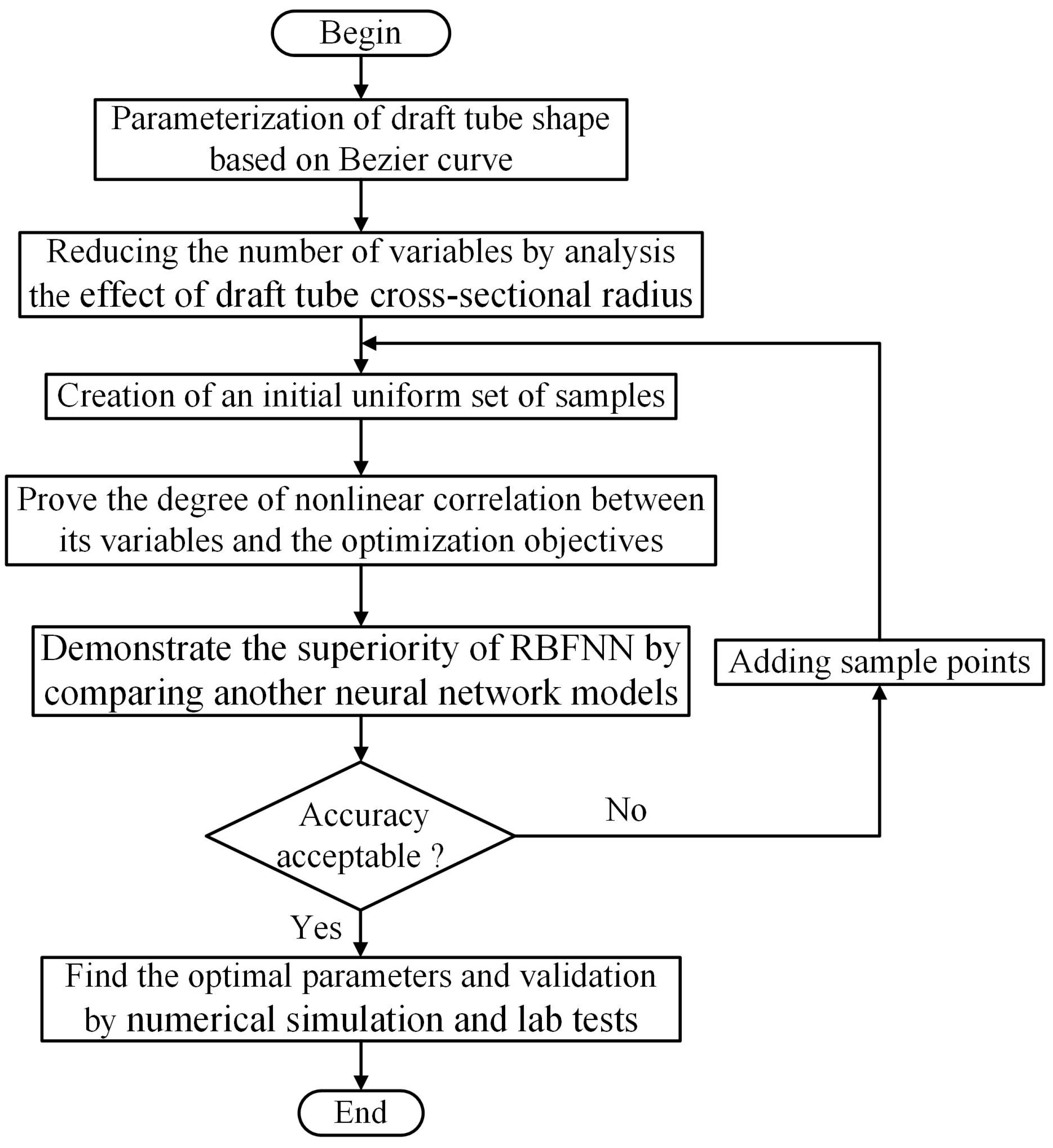



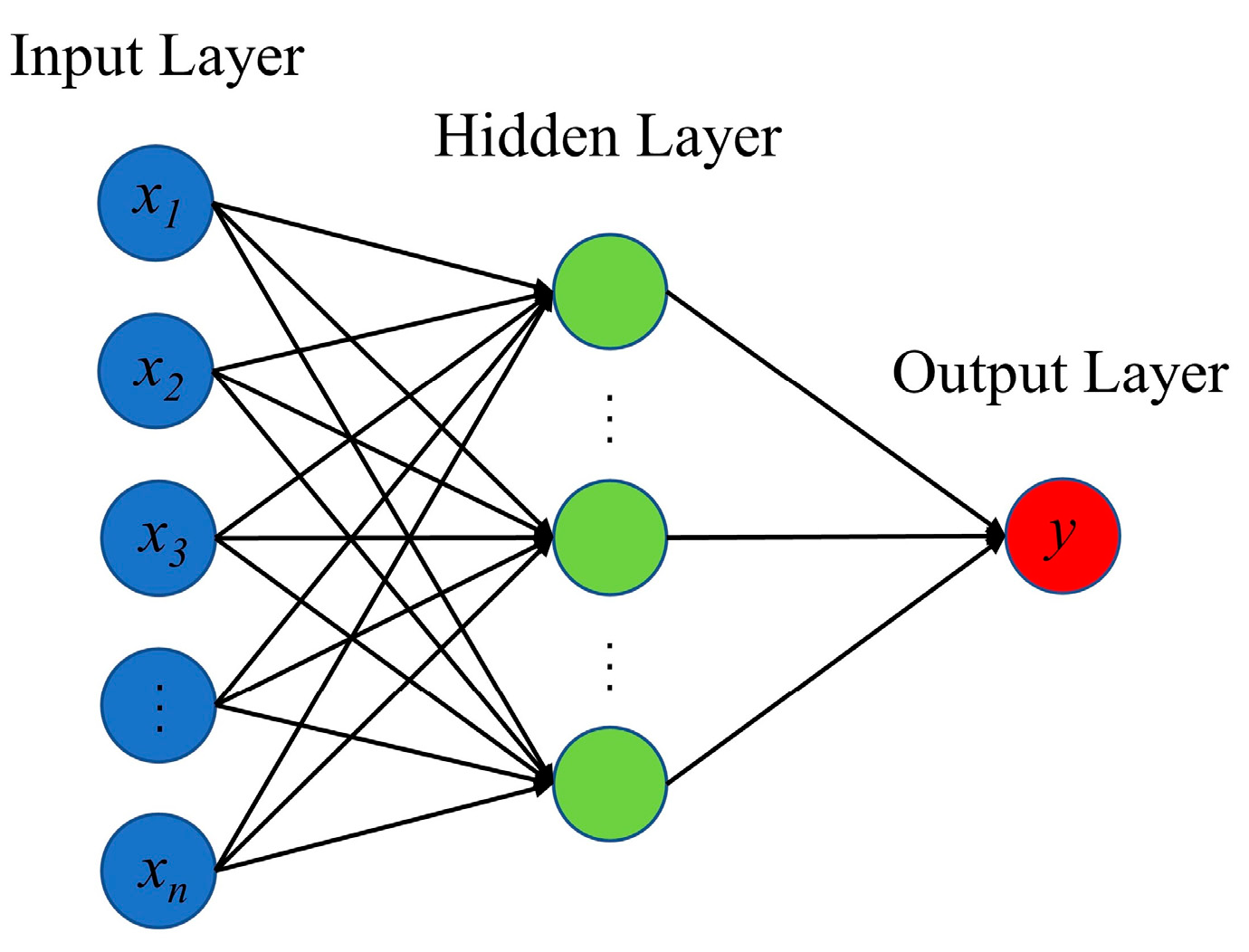
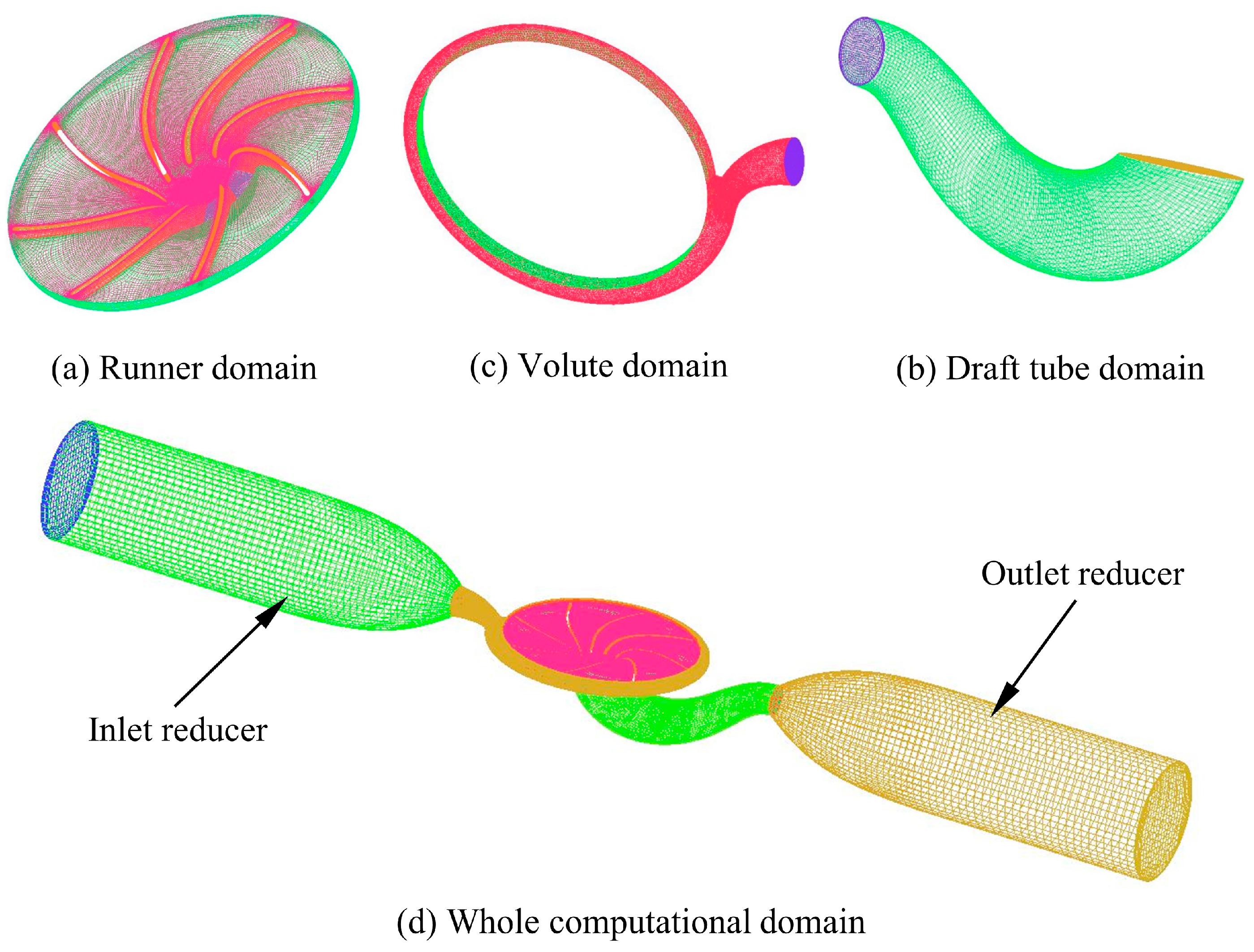

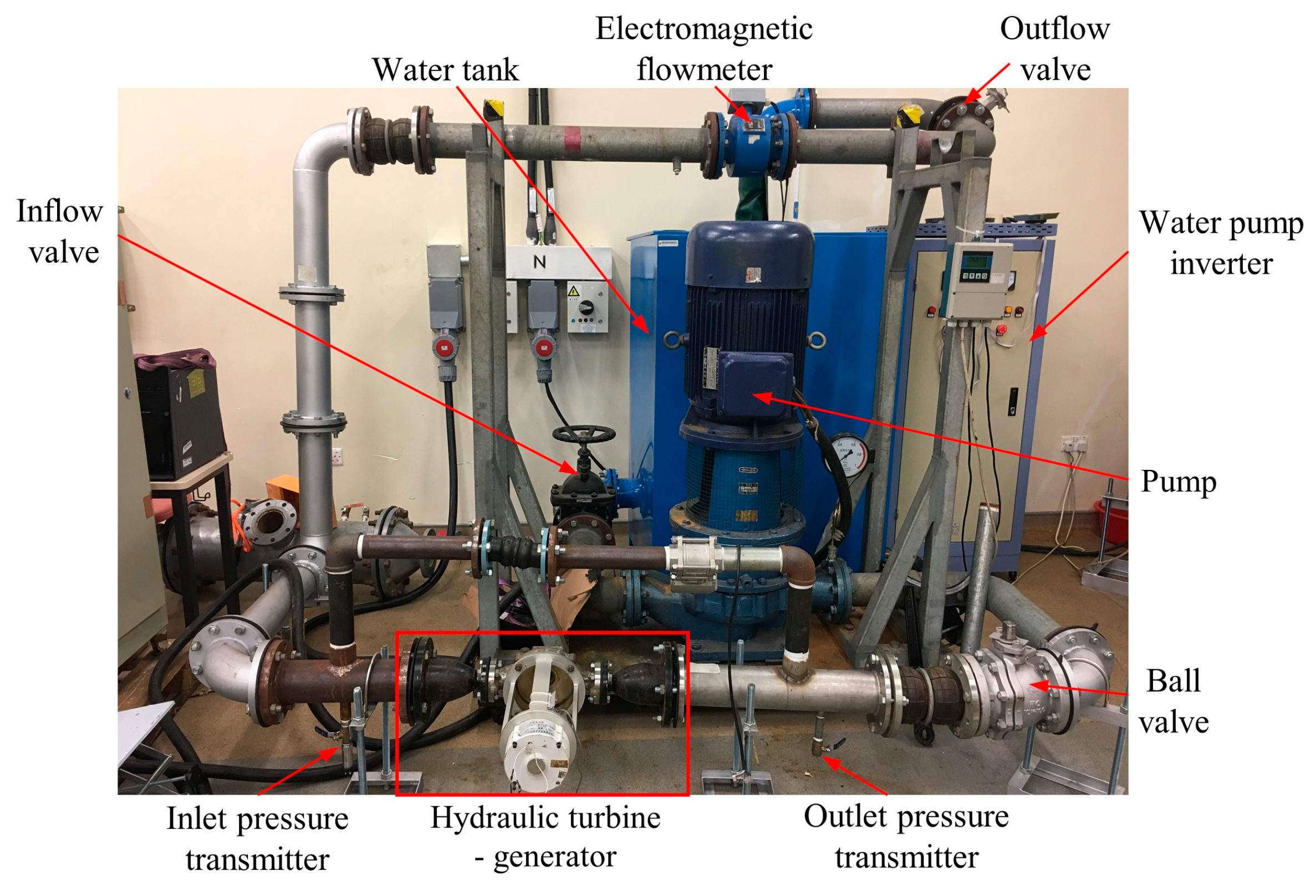
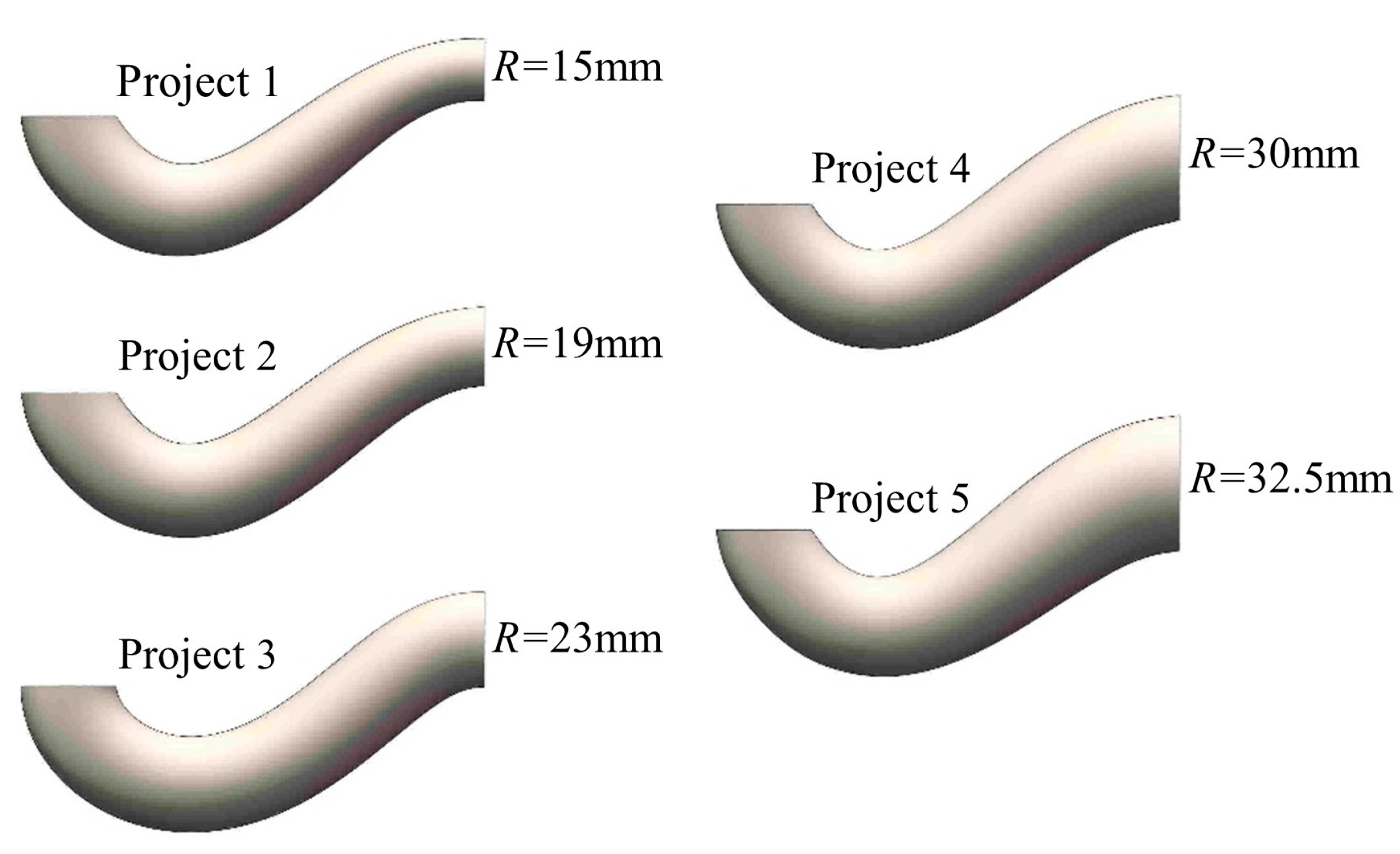
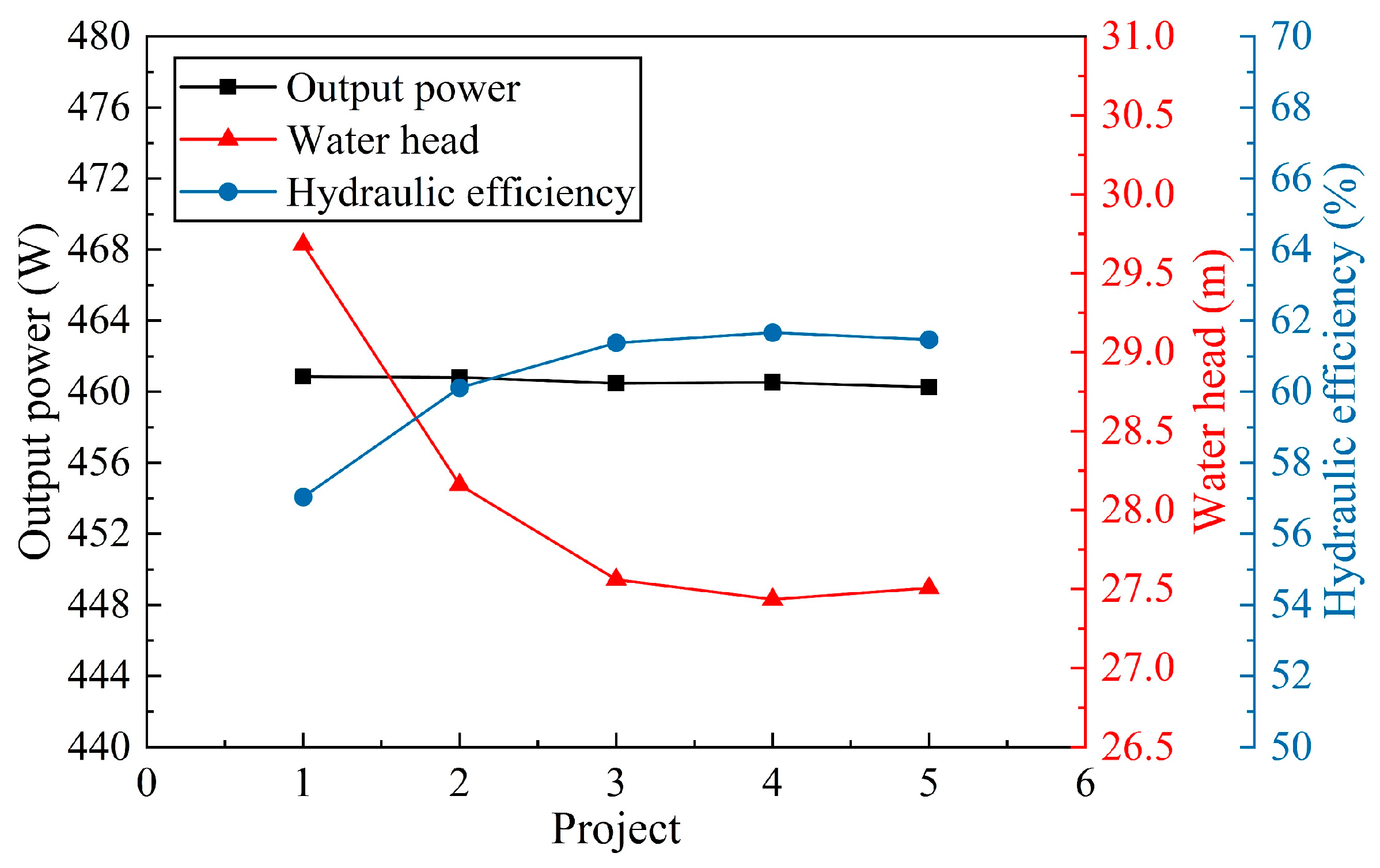

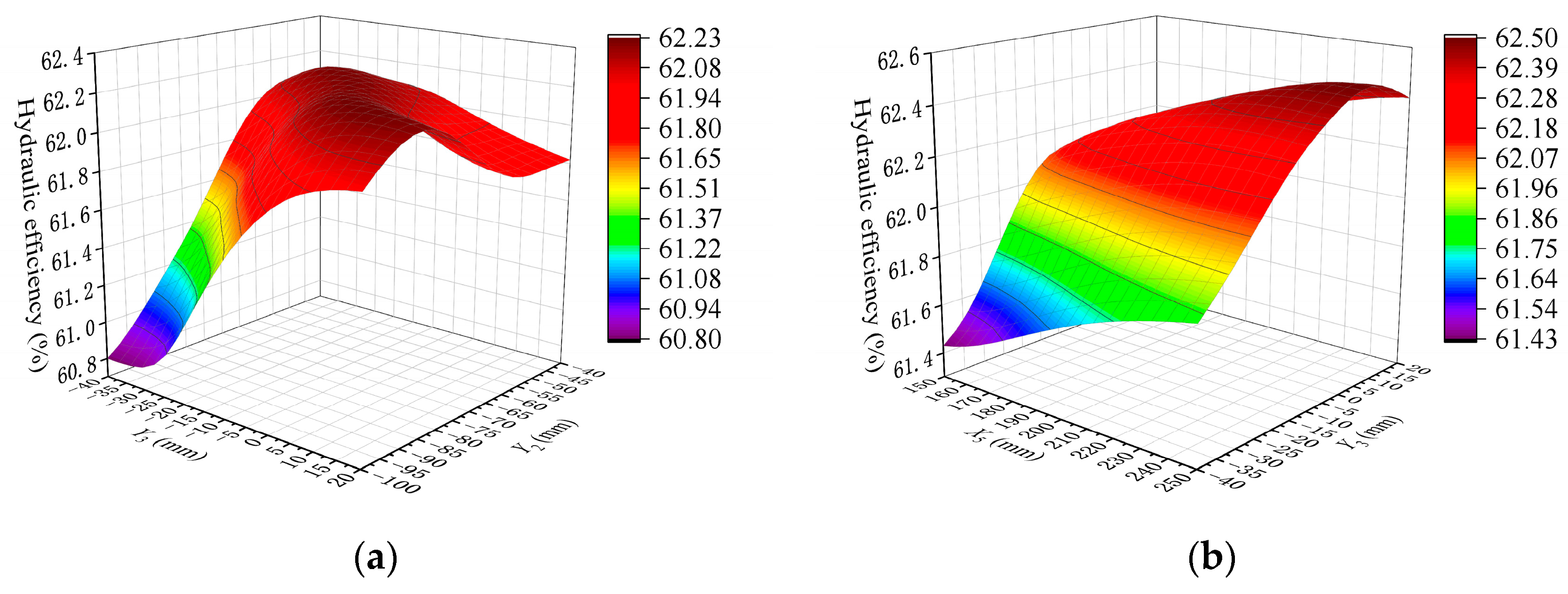
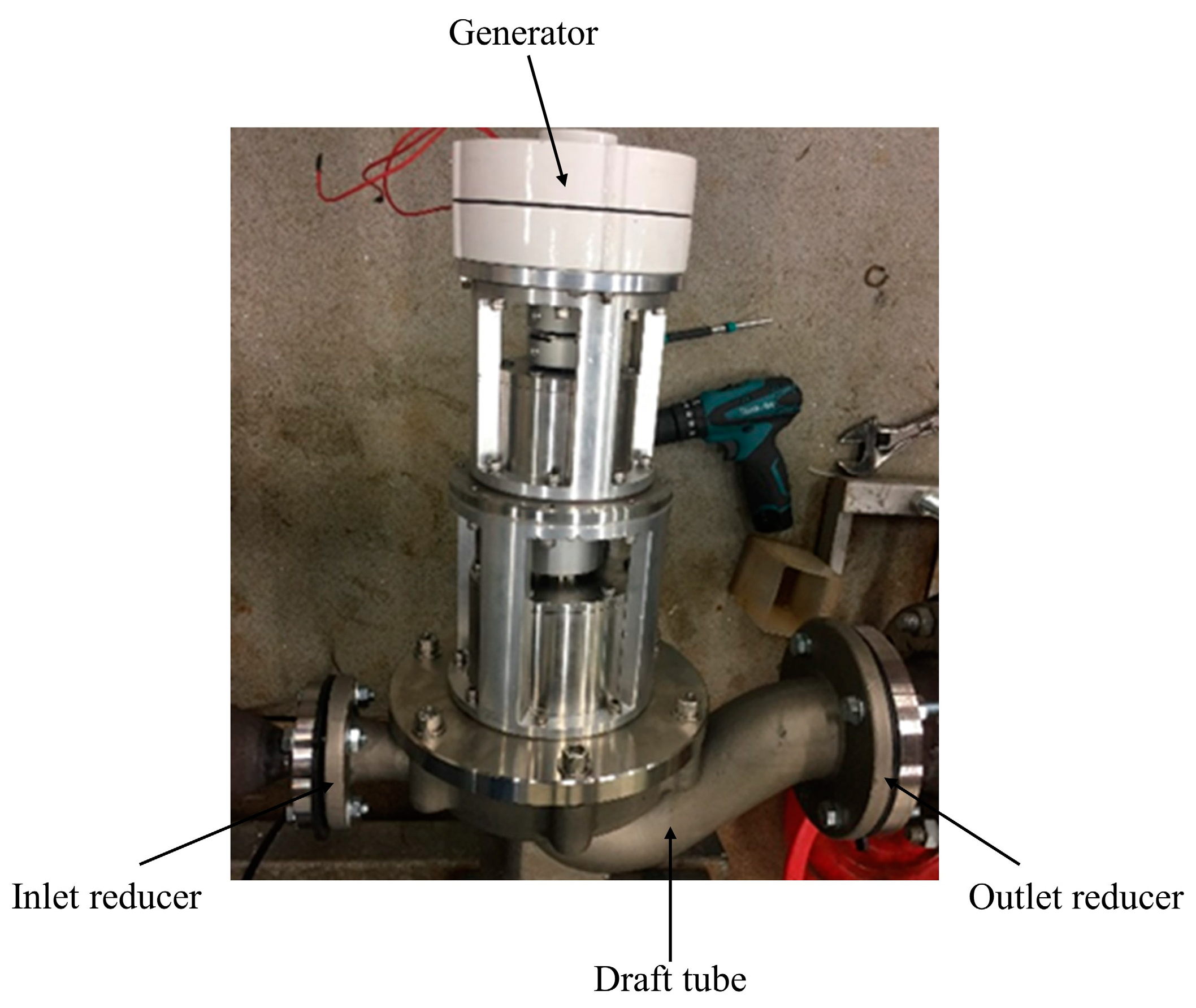
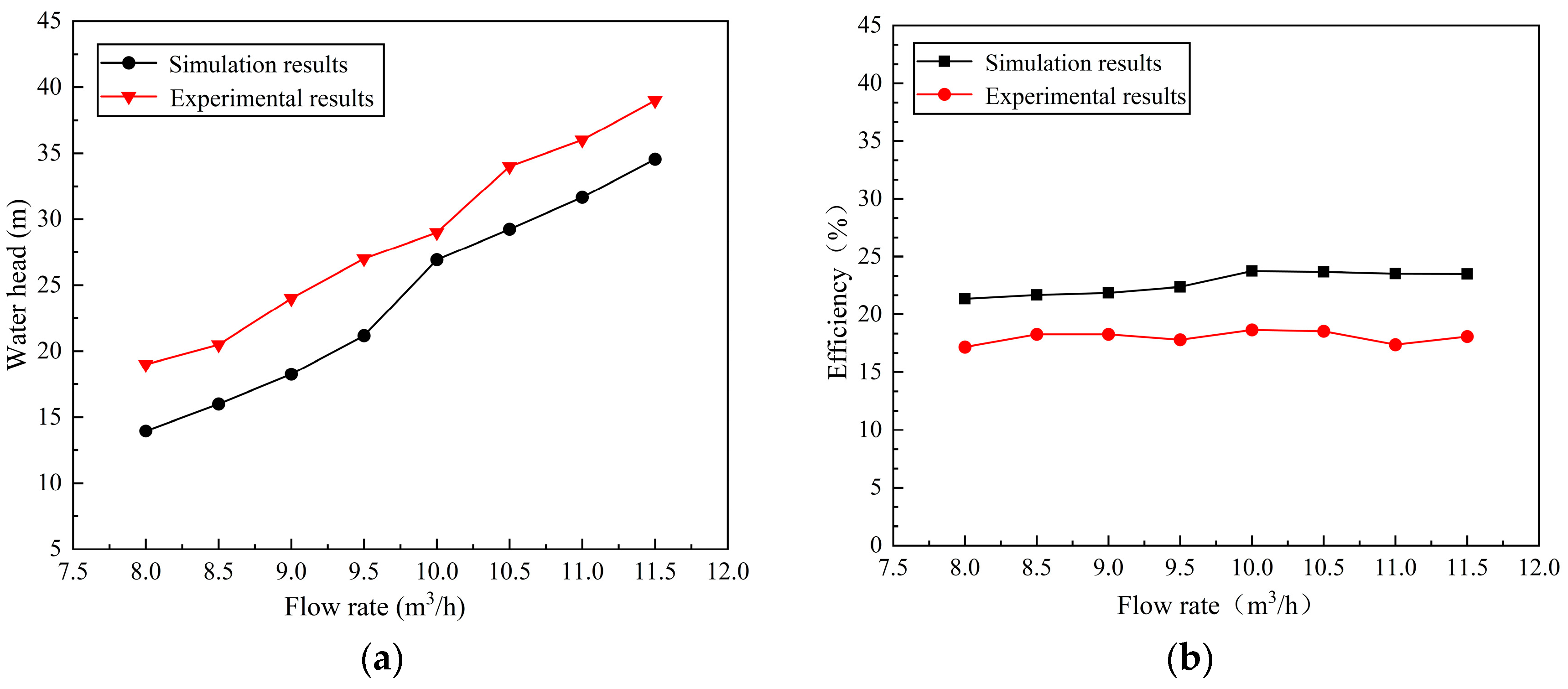
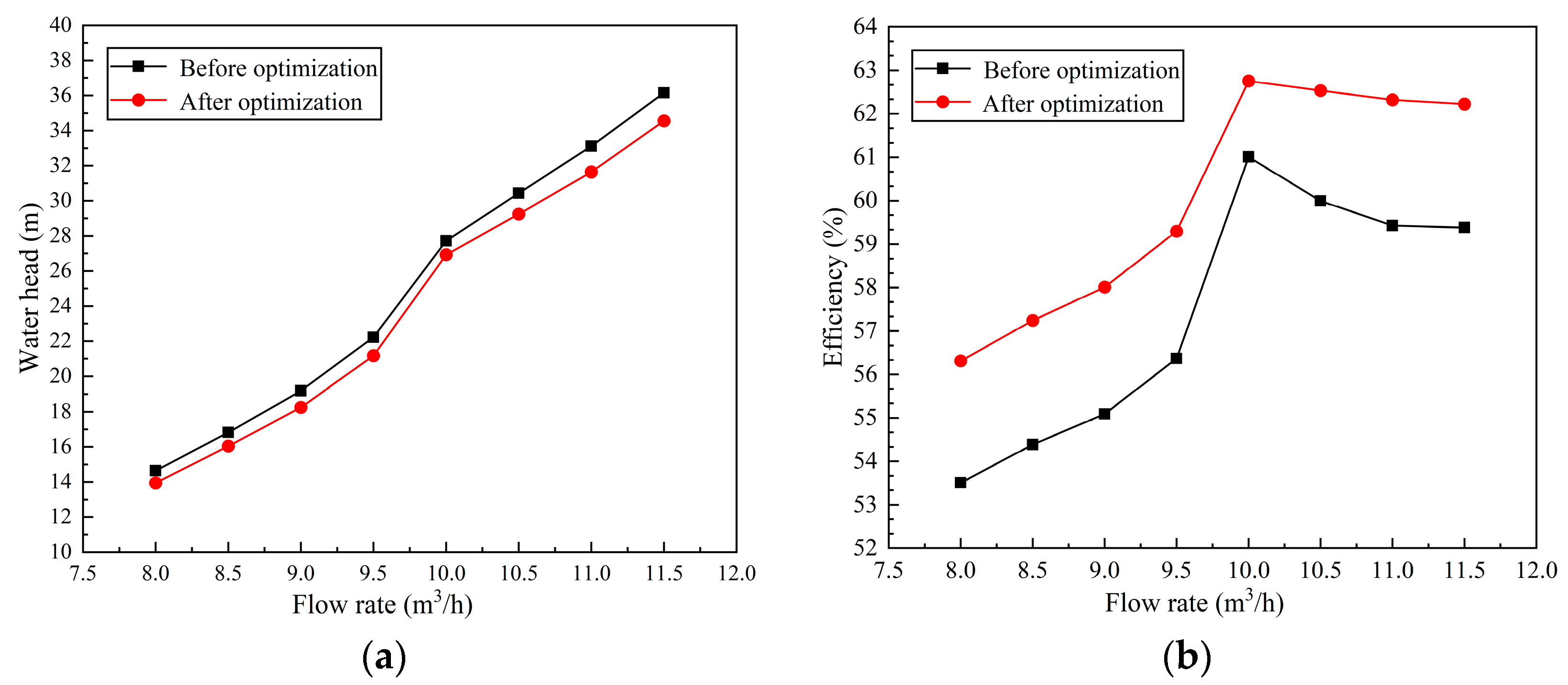


| Project Number | X7 | Y7 | X8 | Y8 | Y9 |
|---|---|---|---|---|---|
| Project 1 | 67.2 | −69.2 | 116.7 | 40.5 | 37.5 |
| Project 2 | 69.8 | −72.6 | 114.8 | 38.6 | 41.5 |
| Project 3 | Isometric distribution (all cross-sectional radii are 23 mm) | ||||
| Project 4 | 67.2 | −69.2 | 116.2 | 46.4 | 52.5 |
| Project 5 | 69.8 | −72.6 | 115.6 | 51.9 | 55 |
| Main Variables Bound Used for Designing and Simulation | |||||
|---|---|---|---|---|---|
| Variables | X2 | Y2 | X3 | Y3 | X5 |
| Boundary (mm) | 60~120 | −100~−40 | 60~120 | −40~20 | 150~250 |
| Serial Number | X2 | Y2 | X3 | Y3 | X5 | Water Head (m) | Hydraulic Efficiency (%) |
|---|---|---|---|---|---|---|---|
| 1 | 91.76 | −97.98 | 75.13 | 8.91 | 202.94 | 27.11 | 62.17 |
| 2 | 85.71 | −88.91 | 98.82 | 17.98 | 220.59 | 26.99 | 62.34 |
| 3 | 109.41 | −54.62 | 114.45 | −0.17 | 150.84 | 27.29 | 61.77 |
| 4 | 70.08 | −76.3 | 107.9 | −33.95 | 158.4 | 27.45 | 61.37 |
| ⋮ | ⋮ | ⋮ | ⋮ | ⋮ | ⋮ | ⋮ | ⋮ |
| 110 | 87.23 | −46.55 | 86.22 | 16.97 | 228.99 | 27.22 | 62.00 |
| 111 | 79.16 | −63.7 | 91.76 | 4.37 | 200.42 | 27.12 | 62.17 |
| 112 | 86.72 | −98.99 | 76.13 | −27.9 | 179.41 | 27.67 | 60.89 |
| 113 | 80.17 | −87.39 | 69.58 | −39.5 | 218.91 | 27.50 | 61.30 |
| 114 | 66.55 | −95.46 | 96.81 | −31.93 | 223.95 | 27.60 | 61.02 |
| 115 | 97.82 | −59.16 | 90.25 | −13.78 | 218.07 | 26.99 | 62.38 |
| 116 | 98.82 | −66.22 | 77.14 | −38.99 | 211.34 | 27.07 | 62.23 |
| 117 | 74.62 | −78.82 | 116.97 | −32.44 | 203.78 | 27.31 | 61.68 |
| Surrogate Model | R2 (Best Value = 1) | RMSE (Best Value = 0) | MRE (Best Value = 0) |
|---|---|---|---|
| Standard response surface function | 0.9149 | 0.1016 | 0.0042 |
| Kriging function | 0.9020 | 0.1090 | 0.0049 |
| Radial basis function | 0.9280 | 0.0930 | 0.0038 |
| Before Optimization | After Optimization | Round Number | |
|---|---|---|---|
| X2 | / | 69.5267 | 69.52 |
| Y2 | / | −75.8488 | −75.84 |
| X3 | / | 113.428 | 113.42 |
| Y3 | / | 8.3927 | 8.4 |
| X5 | / | 239.1079 | 239.11 |
| Water head (m) | 27.72 | 26.91 | 26.93 |
| Hydraulic efficiency (%) | 61.01 | 62.58 | 62.76 |
Disclaimer/Publisher’s Note: The statements, opinions and data contained in all publications are solely those of the individual author(s) and contributor(s) and not of MDPI and/or the editor(s). MDPI and/or the editor(s) disclaim responsibility for any injury to people or property resulting from any ideas, methods, instructions or products referred to in the content. |
© 2024 by the authors. Licensee MDPI, Basel, Switzerland. This article is an open access article distributed under the terms and conditions of the Creative Commons Attribution (CC BY) license (https://creativecommons.org/licenses/by/4.0/).
Share and Cite
Xin, Q.; Wu, J.; Du, J.; Ge, Z.; Huang, J.; Yu, W.; Yuan, F.; Wang, D.; Yang, X. Study of Draft Tube Optimization Using a Neural Network Surrogate Model for Micro-Francis Turbines Utilized in the Water Supply System of High-Rise Buildings. Processes 2024, 12, 1128. https://doi.org/10.3390/pr12061128
Xin Q, Wu J, Du J, Ge Z, Huang J, Yu W, Yuan F, Wang D, Yang X. Study of Draft Tube Optimization Using a Neural Network Surrogate Model for Micro-Francis Turbines Utilized in the Water Supply System of High-Rise Buildings. Processes. 2024; 12(6):1128. https://doi.org/10.3390/pr12061128
Chicago/Turabian StyleXin, Qilong, Jianmin Wu, Jiyun Du, Zhan Ge, Jinkuang Huang, Wei Yu, Fangyang Yuan, Dongxiang Wang, and Xinjun Yang. 2024. "Study of Draft Tube Optimization Using a Neural Network Surrogate Model for Micro-Francis Turbines Utilized in the Water Supply System of High-Rise Buildings" Processes 12, no. 6: 1128. https://doi.org/10.3390/pr12061128




